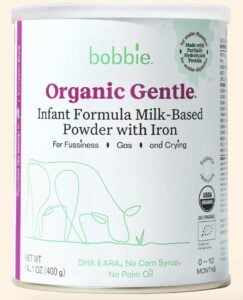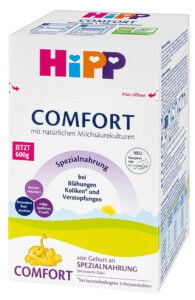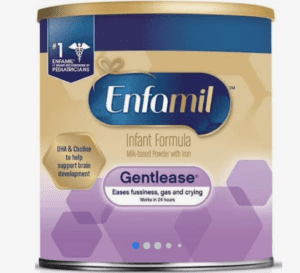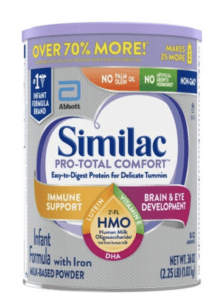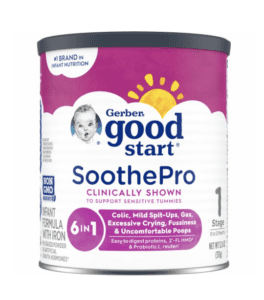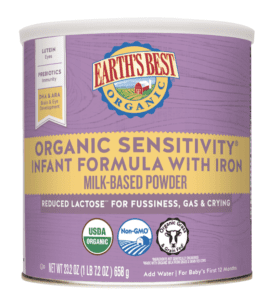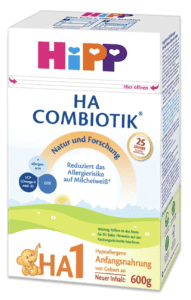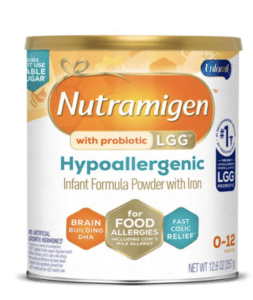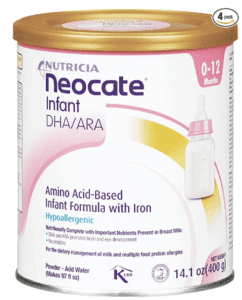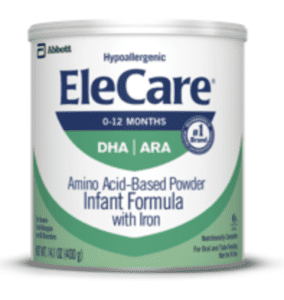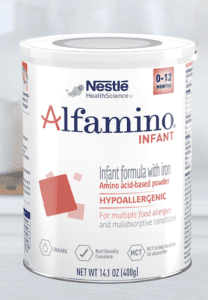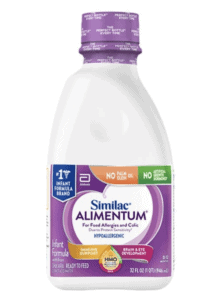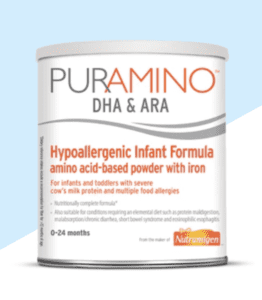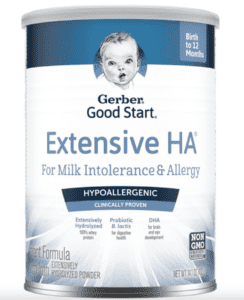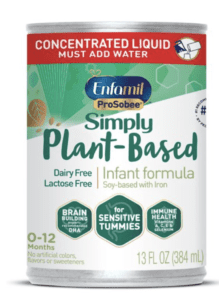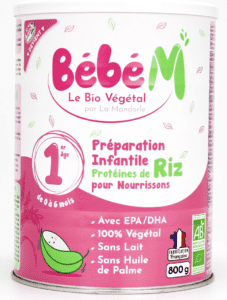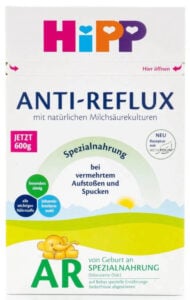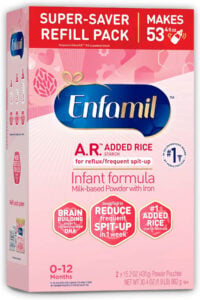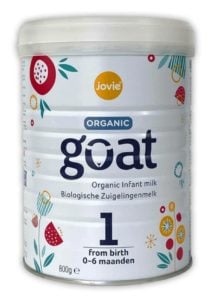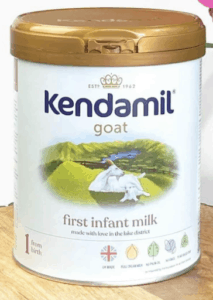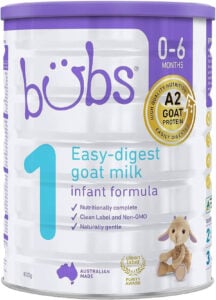Health
The Best Formula for Colic (2024 Guide)

This post may contain affiliate links. As an Amazon Associate, I earn from qualifying purchases. Please read my disclosure.
What is the best formula for colic babies? In this helpful guide, I’ll review what colic is, what causes it, how to soothe a baby with colic, answer common questions about it, and share the best baby formulas for colic!
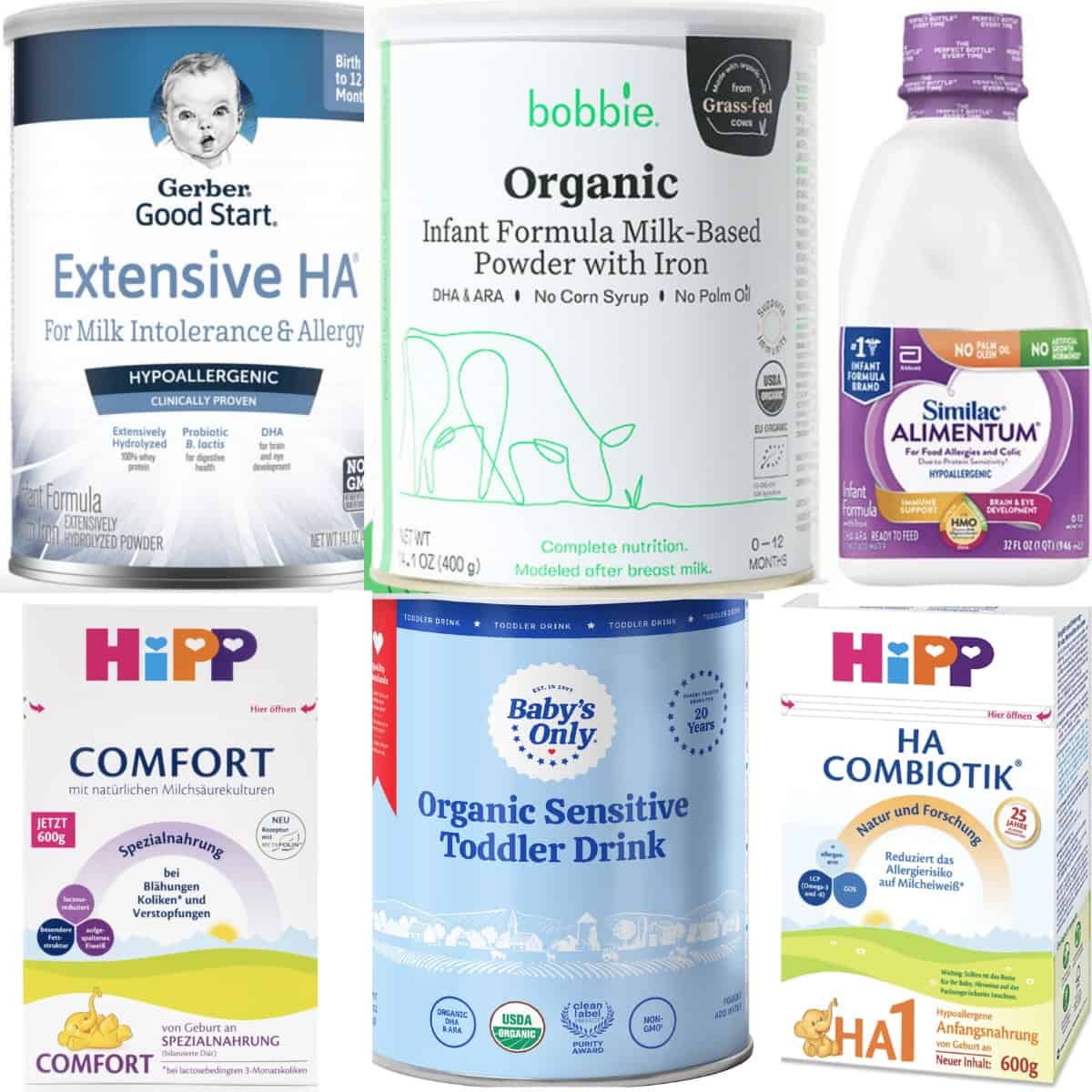
If your infant is excessively crying and fussing for what seems like no reason, you may have a colicky baby on your hands. As parents, nothing is harder than seeing our precious little ones in pain. Colic is extra challenging because the cause of our children’s discomfort can be hard to pinpoint.
You may be wondering how you can help your newborn feel better. Thankfully, there are many ways to help colicky babies. There are also many soothing strategies to apply and special formulas are available to ease colic symptoms and stop your baby’s crying. If you’ve been endlessly searching for the best formula for colic babies or treatments for your little one, this is the guide for you!
Disclaimer
As a board certified health coach and certified nutritionist, I support products and ingredients that are rooted in science and are evidence-based. Using my background in nutrition, extensive research, consultations with experts, and my own experience giving my two kids formula, I arrived at this list of the best formulas for acid reflux in this guide.
Though I may receive a commission (at no extra expense) if you purchase through some of the affiliate links provided, I only recommend products I’ve researched, evaluated, consulted experts on, and would feel comfortable giving to my own two children.
As always, I only share products that are the highest quality and that can help you and your family the most. By purchasing any of these products from the links below, you help keep this blog running, so thanks for your support!
Keep in mind that every baby and situation is different, especially when it comes to colic. Always consult your child’s pediatrician to diagnose and treat colic before starting or switching to a new formula. My recommendations are not a substitute for professional medical advice, diagnosis, or treatment.
Formula prices are current at the time of this publication but are subject to change.
Quick Picks: The Best Formulas For Colic
Here is my shortlist of the best colic baby formulas, categorized by type!
What Is Colic?
Colic, also known as infantile colic, is the frequent and excessive crying of newborns during their first three months of life (source). Technically speaking, it is defined as a baby’s crying for over three hours a day, more than three days per week, and for at least three weeks (source). Experts believe that colic affects at least 20% of babies (source).
Colic can be particularly upsetting and stressful for parents because it can be hard to identify the source of the baby’s distress and common consolation efforts usually do not bring relief. Though the condition can be incredibly frustrating for parents, it is harmless to the baby and disappears by the time they are 3-4 months old (source).
What Are Common Colic Symptoms?
While colic symptoms can vary between babies, features of a baby’s colic typically include (source):
- Crying for No Apparent Reason: Unlike when crying can be remedied by feeding or a diaper change.
- Intense Crying: Colic crying usually sounds more like screaming or like they are in pain.
- Extreme Fussiness: That continues after the baby stops crying.
- Predictable Timing: Colic episodes frequently occur in the evening.
- Body Tension: A tight abdomen, curling their legs up to their tummy while they cry, clenched fists, or stiff legs.
- Flushed Face: Discoloration that looks like intense blushing.
- Gas: Burping often or passing a lot of gas
What Causes Colic?
The exact cause of colic is unknown (source). Medical experts anticipate that it likely results from several factors, such as the following (source, source):
- Inability to self-soothe
- Sensitivity to environmental stimuli (lights, sounds, etc.)
- An immature digestive system that doesn’t yet efficiently process food
- An imbalance of healthy bacteria in the digestive tract
- Cow milk allergy (CMA) or cow milk protein allergy (CMPA)
- Other food allergies
- Overfeeding or underfeeding
- Early forms of childhood migraine
- Hormones
- Gas
At-Home Colic Soothing Remedies
If you think your baby has colic, you can try several home remedies to alleviate some of their discomfort. Here are some at-home colic remedies (source, source):
- Tummy Time: Lay your baby on its tummy or hold them belly-down on your forearm. Gentle pressure on a baby’s belly can sometimes help relieve colic. Rubbing their back is also soothing and helpful for passing gas.
- Hold, Wear, or Carry Them: Colicky or gassy babies often respond well to being held. If holding them for long periods of time isn’t doable, consider wearing them in a baby wrap or carrying them in a baby carrier.
- Repetitive Motion: Take your baby for a walk, rock them, use a baby swing, or even take them for a drive. The repetitive motion is known to help soothe colic symptoms.
- Sit Upright After Feeding: Sometimes, gastroesophageal reflux (in the form of acid reflux or gastroesophageal reflux disease, GERD) is what causes your baby’s colic. This means that your baby experiences a form of heartburn as breast milk or formula comes back up their esophagus after eating. Holding them upright can reduce these acid reflux symptoms.
- Thicken Milk or Formula with Infant Cereal: To reduce reflux, you can add infant rice milk to formula or breast milk as a thickening agent. Always confirm this remedy with your child’s doctor before implementing it.
- Use Anti-Colic Baby Bottles: Or, bottles specifically designed to prevent colic by limiting the amount of air entering the milk or formula during feeding.
- Check the Bottle Nipple Size: Ensure your baby’s milk flow isn’t too fast. Also, always keep the formula in the nipple while your child feeds to limit excess air consumption while feeding.
- Create A Calming Atmosphere: Turn on a white noise machine, hold or feed your baby in a cool and dark room, or limit ambient noise or stimulation to help calm your baby’s (and your) nervous system!
- Try a Different Formula: If your baby isn’t responding well to your current formula, exploring other options with your child’s pediatrician might be a good idea. A hypoallergenic, anti-reflux, lactose or milk-free, or sensitive formula might do the trick. See my list below for more information.
Can Baby Formula Cause Colic?
In short, baby formula can create or exacerbate colic symptoms but it isn’t a condition limited to only formula-fed babies (source). Breastfed babies can also struggle with colic.
If formula feeding, bottle feeding too quickly– finishing a bottle in less than 20 minutes– or giving your baby too much formula can cause reflux, aggravating colic symptoms (source). Additionally, the lactose or milk sugar present in standard infant formula may also be a source of discomfort for your baby or your child may have a food allergy, such as cow milk allergy (CMA; source, source).
If you are concerned if any of these situations are contributing to your infant’s colic, reach out to your child’s pediatrician for diagnosis and to discuss if you should change your child to a different formula.
What To Look For When Choosing A Baby Formula For Colic
While the best formula for your colicky baby will depend on their specific needs (more of that below!), there are a few things you should look for when choosing the best formula for colic:
- Probiotics and Prebiotics: These can help ease digestion by balancing the gut microbiome, easing colic symptoms (source).
- Non-GMO and Organic Ingredients: Not only do organic or non-GMO formulas tend to have more probiotics, prebiotics, and healthy fats, but studies show that the organic lactose in them is easier for babies to digest than conventional lactose(source), meaning that they could naturally help with colic symptoms associated with problematic digestion. Note: some hydrolyzed protein formulas cannot be labeled organic due to how the hydrolyzed proteins are produced. If your doctor recommends this formula for your baby, you can look for a hydrolyzed protein formula with otherwise organic ingredients.
- Additives That Enhance Growth & Development: Such as DHA and ARA. DHA and ARA are essential fatty acids that have been known to support infant brain and eye development, the immune system, and overall growth (source). They are naturally occurring in breast milk, so many experts believe they are beneficial to have in formula as well (source). The Food and Drug Administration (FDA) doesn’t require that these are added to formula so check with the brands you are considering to see if they include them.
A note on corn syrup, syrup solids, and maltodextrin in colic formula: When it comes to general milk-based formula, I almost always recommend brands that contain lactose as their main source of carbohydrates. However, the same guidelines usually do not apply to hypoallergenic formulas. Whereas some colicky babies can tolerate hypoallergenic formula containing organic lactose, children diagnosed with lactose intolerance, cow milk allergy (CMA), or cow milk protein allergy (CMPA) need to avoid it altogether.
Therefore, the best formula options for many children with food allergies are hypoallergenic formulas made with corn syrup, corn syrup solids, or maltodextrin. Some vegan brands, such as BéBé M have a corn or rice base, but these brands can be harder to find or more expensive.
Breastfeeding And Colic
Many are quick to suggest eliminating foods from the breastfeeding mother’s diet upon the onset of a breastfeeding baby’s colicky symptoms. There are many potential issues that could be causing infant upset that need to be addressed before eliminating foods, such as (source, source):
- Not having a good latch
- Slow milk letdown reflex
- Fast milk letdown reflex
- Switching breasts too early or often during feeding
- Timing feedings
- Reflux or gas after feedings
- Infant hunger
- Probiotic imbalance
For example, if the baby is not latched properly, they may take in too much air as they feed, causing digestive distress during and after feeds. They may also not ingest enough milk, crying after feeding because they are still hungry.
Babies timed at the breast or prematurely switched to the second breast may still be hungry after feeding. This means that they received an abundance of the lactose-rich foremilk but a lack of the fat and protein-rich hindmilk that comes after. When this happens, babies exhibit lactose intolerance symptoms when they just need the full supply of milk to balance the milk composition and soothe their digestion.
Often, changing your diet or switching to formula is unnecessary. Sometimes, switching to formula helps infants because bottle feeding regulates the flow of milk and prevents excess airflow. In such situations, pumping and bottle-feeding breast milk may be just as helpful for the infant, regardless of the mother’s diet (source).
If you are concerned that breastfeeding may be causing your baby colicky symptoms or need help sorting them out, a licensed lactation consultant or your child’s pediatrician can help. They can help troubleshoot the issues that may be causing your child’s discomfort and find a solution that works best for you and your baby.
New research is also exploring the connection between probiotics and colic (source). In these studies, experts are finding that the addition of Lactobacillus reuteri DSM 17938 has the potential to reduce infantile colic symptoms by up to 50%. If you are interested in giving probiotics to your child to treat their colic, discuss this with your child’s pediatrician before adding them to their diet.
If your child still has colic symptoms after troubleshooting all of the non-dietary-related options, consider removing foods from your diet. On some occasions, proteins in the mother’s diet pass through their milk, affecting the infant. Usually, these aggravating proteins are from cow’s milk.
In such situations, testing out removing the following products from your diet one at a time until you have noticed an improvement in your child’s symptoms (source):
- Dairy: Milk, yogurt, cheese, ice cream, cottage cheese, and more (see more here).
- Caffeine: Coffee, chocolate, tea, and energy drinks.
- Certain Vegetables & Beans: Broccoli, cauliflower, brussels sprouts, cabbage, garlic, onions, and beans.
- Certain Fruits: Melons, stonefruit (apricots, plums, prunes), and rhubarb.
Note: If breastfeeding and dietary troubleshooting do not resolve your baby’s colic symptoms, contact your doctor to discuss taking oral enzymes (source) or temporarily transitioning to a hypoallergenic formula (source).
Types Of Formula To Help With Colic
There isn’t one best baby formula for colic that works for all babies, as the right formula will depend on your baby’s specific circumstances. Below is an overview of the different types of formulas that can help with colic and the situations in which they can be helpful.
Always remember to see your child’s doctor to diagnose colic. The doctor’s diagnosis will dictate which is the best colic formula for your baby.
Sensitive Formulas
Sensitive formulas are made with partially hydrolyzed proteins, which means that the milk proteins are partially broken down to make them easier to digest. Many also contain reduced lactose, prebiotics, or probiotics to support gentle digestion. Sensitive formulas are generally less expensive than hypoallergenic formulas and can be a good fit for infants who have been diagnosed with lactose intolerance or sensitivity to dairy.
Hypoallergenic
This type of formula is made with extensively hydrolyzed or fully hydrolyzed proteins. These proteins are broken down into smaller pieces, or “pre-digested,” making them easier for infant digestive systems to process and less likely to cause an allergic reaction.
Within this category, there are extensively hydrolyzed formulas and amino acid formulas. Extensively hydrolyzed are formulas in which the milk proteins are broken down to the extent that the body does not recognize them. Amino acid formulas are made with amino acids, the elemental building blocks of protein (source).
Both forms of hypoallergenic formulas are great options for cow’s milk allergy, cow’s milk protein allergy, and multiple food allergies. Hypoallergenic formulas are the most expensive type of formula on this list, but some insurance companies can cover all or part of the cost if your child’s pediatrician deems them medically necessary.
Acid Reflux (AR) Formula
This is the least common type of formula for colic, but an acid reflux formula can be helpful if your child’s doctor determines that acid reflux is the culprit for your child’s colic symptoms. Many of these formulas are thickened with rice to help them stay in the stomach, reducing regurgitation
Goat’s Milk & A2 Milk Formula
These formulas are sensitive or good for digestion not because of hydrolyzed protein but because of their particular type of milk protein. Whereas cow’s milk contains the A1 beta-casein protein, goat milk and A2 milk contain the A2 beta-casein protein, which is easier to digest (source). Therefore, because goat milk and A2 milk formulas contain the A2 beta-casein protein they can be easier for babies to digest.
The Best Formulas for Colic
If you have a colicky baby at home, you may choose to turn to a specialized formula to help ease symptoms. If you’re interested in giving this a go, here are my top picks for the best formula for colic babies.
Sensitive Formulas
Bobbie Organic Gentle Formula
Why I Love It: When it comes to the best formulas for babies with gas, fussiness, and crying, Bobbie Organic Gentle is at the top of the list. This sensitive formula is made in the United States but with a European-style recipe. Bobbie is a female-founded and mom-led infant formula company that makes organic formulas modeled after breast milk.
Bobbie Organic Gentle is made with organic partially hydrolyzed protein and organic lactose for easier digestion. This formula is a fantastic option for babies who have trouble tolerating intact milk protein but are not diagnosed with milk or food allergies. Bobbie is also made without palm oil, which can be known to lead to constipation in babies.
Though the flagship Bobbie Formula is available at Target, Organic Gentle is only available on the Bobbie website. They offer a super convenient subscription service so you never run out of formula. You can even modify or adjust it to send it to a new address when you are traveling or cancel it at any time, no questions asked!
The only main drawback of this formula is that it does not contain probiotics or prebiotics, but Bobbie does now offer an infant probiotic supplement. These probiotic drops are made with a USDA organic probiotic that has been studied to support calm digestion and reduce colic symptoms. Note: always talk with your doctor before adding additional supplements like this to your baby’s diet.
Where To Buy: Company Website
Cost: $28 for a 14.1 oz canister of formula powder.
Partially hydrolyzed whey protein
Clean Label Project Purity Award winner
Formulated to support infants who express excess gas, fussiness, or crying
European-style formula made in the U.S.
Easy subscription model (so you’ll never have to worry about running out of formula!)
No corn syrup, syrup solids, or sugar
No palm oil, no soy allergens
Contains DHA and meets EU standard for DHA
Doesn’t contain prebiotics or probiotics
HiPP Comfort UK
Why I Love It: Created specifically for the dietary management of colic and constipation, HiPP Comfort UK is a non-GMO powdered formula made with hydrolyzed protein, reduced lactose content, and probiotics. Discuss this formula for colicky babies with your child’s pediatrician if they recommend a baby formula for lactose-induced colic and constipation.
This formula contains essential fatty acids omega-3s (DHA) and omega-6s (ARA) to support cognitive and vision development, prebiotics for the immune system, and a unique fat blend to improve nutrient absorption. Come of the essential fatty acids are added via fish oil, making this formula not vegetarian-friendly. Otherwise, it is a nutritious and high-quality sensitive formula option, however.
Where To Buy: The Milky Box
Cost: $47.99 for an 800g box of formula powder. Buy in bulk for as low as $41.99 per box.
Made with hydrolyzed proteins
Meets European Union standards (EU Certified)
No corn syrup, syrup solids, or sugar
HiPP Comfort Classic
Why I Love It: Another fantastic HiPP offering, this Comfort Classic powdered formula is made with hydrolyzed proteins, reduced lactose, and a special fat composition that mimics breast milk to support gentle and comfortable digestion. It is a great option for little ones experiencing digestive discomfort associated with colic or the inability to digest intact proteins easily.
The main difference between HiPP Comfort Classic and HiPP Comfort UK is that this variety f contains probiotics (Lactobacillus Fermentum CECT5716)—the same probiotic found in human breast milk—maltodextrin and slightly higher levels of lactose. Unfortunately, the Comfort Classic also contains fish oil, making both formulas unsuitable for babies following a vegetarian diet.
Note: HiPP Comfort Classic does contain palm oil, but it is certified by independent inspection bodies to be sustainably cultivated.
Where To Buy: Baby Milk Bar, The Milky Box
Cost: $39.99 for a 600g box of the formula powder. Buy in bulk for as low as $35.14 per box.
Formulated specifically to ease gas, constipation, colic, and fussiness
86-87% hydrolyzed whey protein
Includes DHA & ARA, along with special fat blend
More expensive than some of the other formulas on this list
Contains palm oil (though sustainably sourced)
Enfamil NeuroPro Gentlease
Why I Love It: With 80% lactose than traditional milk-based formulas and partially hydrolyzed proteins, Enfamil NeuroPro Gentlease is a milk-based infant formula designed to help reduce crying, gas, and spit-up within 24 hours. It is made with a whey-to-casein ratio of 60:40, like mature breast milk, supporting gentle infant digestion.
This non-GMO formula contains DHA for brain and eye development and prebiotics to support digestion and the immune system (source). Unfortunately, the main source of carbohydrates in NeuroPro Gentlease is corn syrup solids; otherwise, this product is one of the best formulas for colic and gas.
Note: If your child is diagnosed with a milk allergy or lactose intolerance, this brand might not be allergen-friendly enough since it contains milk and lactose. Always consult your child’s physician for the best formula recommendation for your child.
Where To Buy: Amazon
Cost: $59.84 for a 998g box of formula powder. Subscribe and save for up to 15% off.
Made with partially hydrolyzed proteins
80% less lactose than most traditional formula brands
Has a whey-to-casein ratio of 60:40 (the same as mature breast milk)
Clinically proven to reduce fussiness, crying, and gas in 24 Hours
Contains corn syrup solids
Does not contain probiotics
Similac Pro Total Comfort
Why I Love It: Made with partially hydrolyzed whey protein, Similac Pro Total Comfort is formulated for gentler digestion. In fact, parents report that their children had reduced colicky symptoms of fussiness and crying within one day of feeding this formula.
This formula contains prebiotics, DHA, and ARA. It is made with corn maltodextrin instead of corn syrup, limiting processed sugars while minimizing dairy and lactose. One of the best aspects of this formula that parents will love is its price: it is one of the more affordable options on this list, coming in at $33.69 for a 20.1 oz tub, or up to half the price of some other colic formula.
Cost: $33.69 for a 20.1 oz tub of formula powder. Subscribe and save up to 15%.
Non-GMO and no artificial growth hormones
Does not contain corn syrup
Contains prebiotics (2’-FL HMO)
Is formulated for easier digestion
More affordable than some other sensitive formulas
Does not contain probiotics
Similac Total Comfort European
Why I Love It: Very similar to Similac Pro Total Comfort, Similac Total Comfort is manufactured in Spain and started being imported into the United States during the 2022 formula shortage.
This formula is made with hydrolyzed proteins, making it easy to digest and good for babies who have difficulty tolerating traditional milk-based formulas. It contains prebiotics to support your child’s immune system, DHA and ARA to support brain and eye development, and is non-GMO.
Similac Total Comfort European is one of the more budget-friendly formulas on this list. It is much more affordable than Similac Pro Total Comfort, it’s America-made counterpart, as well. Like Pro Total Comfort, this formula uses maltodextrin as a carbohydrate source instead of corn syrup and it doesn’t contain palm oil.
Where To Buy: Amazon
Cost: $32.07 for an 820g (28.9 oz) canister of formula powder. Subscribe and save for up to 15% off.
Partially hydrolyzed proteins
Meets EU standards for baby formula
Does not contain corn syrup
Very affordable compared to other specialty formulas
Does not contain probiotics
Gerber Good Start Soothe Pro
Why I Love It: If you’re looking for a formula for a colic baby that doesn’t break the bank, Gerber Good Start SoothePro is another great option. At $32.25 for a 19.4-oz canister, this formula is made with reduced lactose, corn maltodextrin instead of corn syrup, hydrolyzed whey protein, prebiotics, and probiotics. The probiotic lactobacillus reuteri has been proven to improve infant digestion in studies, reducing the crying, fussiness, and gas commonly associated with colic (source).
Although corn maltodextrin isn’t the ideal carbohydrate source in formulas because it is processed, it is a valuable source of lactose-free energy for babies with cow milk allergy (source).
This Gerber formula is also non-GMO and contains DHA and ARA. It is easy to find on Amazon and many major retailers. Unfortunately, it contains palm oil and soy but is a great sensitive formula for colic babies.
Cost: $32.25 for a 19.4 oz canister of formula powder. Subscribe and save up to 15%.
30% less lactose than traditional formulas
Contains probiotics studied to reduce crying
No sugar, corn syrup, or syrup solids
Some parents report this formula is hard to mix according to customer reviews
Earth’s Best Organic Sensitivity Infant Formula
Why I Love It: This reduced-lactose formula is designed specifically for babies with fussiness, gas, or crying. It is easier for tiny tummies to digest, fortified with iron, and contains ARA and DHA.
This formula is not hydrolyzed, so it may not work for babies with a cow’s milk allergy, but otherwise is a good option to support gentle digestion. If your child’s pediatrician recommends a hydrolyzed protein formula, consider Earth’s Best Organic Gentle Formula.
Some customers say their babies don’t love the taste of this formula, however, others have said the opposite. Every baby has their preference, so it’s all about finding the best option for your child.
Where To Buy: Amazon, Target, & Walmart
Cost: $39.99 for a 21 oz canister of formula powder. Subscribe and save up to 15%.
Contains corn syrup solids and glucose solids
Does not have hydrolyzed proteins
Hypoallergenic Formulas
HiPP HA
Why I Love It: Made with hydrolyzed cow milk proteins which are easier for your little one to digest, HiPP HA is created specifically for babies with sensitive stomachs. Though HiPP HA cannot be certified organic because of the hydrolyzed proteins, the rest of the ingredients are organic and non-GMO.
This hypoallergenic formula also contains probiotics, prebiotics, DHA, and ARA, making it a complete nutrition source for your child. Of all the formulas on this list, this option is the most like breast milk, making it the best baby formula for colic.
HiPP HA does contain lactose so it isn’t a good option for children with CMA or CMPA. The DHA and ARA are also derived from fish oil, making it not vegetarian-friendly.
Where To Buy: The Milky Box, Baby Milk Bar
Cost: $41.99 for a 600g box of formula powder. Buy in bulk for as low as $34.99 per box.
Hydrolyzed cow milk proteins
All other ingredients (besides hydrolyzed proteins) are non-GMO and organic
Contains prebiotics and probiotics
Not ideal for lactose intolerance or cow’s milk allergy
Contains palm oil (though sustainably sourced)
Enfamil Nutramigen
Why I Love It: If your doctor determines that lactose intolerance, cow milk allergy, or cow milk protein allergy is causing your baby’s colic, Nutramigen is a great formula. It is made with hydrolyzed proteins and probiotic LGG (lactobacillus rhamnosus GG), which has been studied to help soothe digestion in colicky babies (source).
Enfamil claims that this colic baby formula is clinically proven to reduce colic due to cow’s milk allergy within 48 hours. It also helps babies overcome cow’s milk allergy so they can return to consuming traditional formula in as soon as 6 months.
Nutramigen is made with corn syrup solids and modified corn starch, but since lactose is problematic for children with lactose intolerance, alternative carb sources like corn syrup are necessary. Nutramigen is the #1 pediatrician-recommended formula brand for cow’s milk allergy and a best formula for colic and gassy babies.
Cost: $69.99 for a 27.8 oz can of formula powder. Buy in bulk for $67.99 per can.
Has hydrolyzed milk proteins for easy digestion
Specifically designed baby formula for gas and colic
Lactose-free and dairy-free
Contains probiotics proven to improve infant digestion
Contains corn syrup solids
Slightly more expensive than other colic formulas
Neocate
Why I Love It: If your child was diagnosed with milk or other food allergies, Neocate Infant Formula is one of the best picks. With a 100% dairy-free amino acid base, it was designed specifically for infants with CMA, multiple food allergies (MFA), and other related medical and dietary conditions.
Unfortunately, because this formula is dairy-free, its main carbohydrates come from corn syrup solids. Otherwise, it contains DHA and ARA, is made in a dairy protein-free facility, contains no artificial colors, flavors, or sweeteners, and is the only hypoallergenic formula to be soy-free.
Note: Neocate is a specifically formulated medical food and should only be given to children under medical supervision. Always consult your child’s pediatrician before starting them on Neocate or making any changes to their diet.
Where To Buy: Amazon
Cost: $44.30 for a 14.1 oz canister of the formula powder.
Dairy-free and lactose-free
Amino acid-based for easy digestion
Developed specifically for CMPA and MFA
Does not contain palm oil
Contains corn syrup solids
Does not contain probiotics
Does not contain prebiotics
Some customers claim that their babies dislike the taste
Elecare
Why I Love It: If your child’s doctor determines that your child’s inability to tolerate intact or hydrolyzed protein is at the root of their colic symptoms, EleCare is a great option. It is made with free amino acids, is hypoallergenic, and contains DHA and ARA for brain and eye development and medium-chain triglycerides for fat absorption.
Pediatric gastroenterologists recommend EleCare the most. It is one of the more expensive options on this list, but some insurance companies will cover the cost of a hypoallergenic formula if it is medically necessary.
Where To Buy: Amazon & Walmart
Cost: $48.98 for a 14.1 oz canister of formula powder. Subscribe and save up to 15%.
Amino acid-based for easy digestion
#1 brand for allergies and colic recommended by pediatric gastroenterologists
Contains medium-chain triglycerides to facilitate fat absorption
Does not contain probiotics
Does not contain prebiotics
Nestlé Alfamino
Why I Love It: Another formula created for CMA/CMPA and MFA, Nestlé Alfamino Infant Formula meets the American Academy of Pediatrics (AAP) criteria for being hypoallergenic. It is made with free amino acids which are easy on infant digestion and medium-chain triglycerides (MCT) which help improve fat absorption.
Alfamino does not contain DHA, ARA, probiotics, or prebiotics, and the number one source of carbohydrates is corn syrup solids, but if severe food allergies are at the root of your child’s colic, this brand could be a good one to discuss with your child’s doctor.
Where To Buy: Amazon
Cost: $47.49 for a 14.1 oz canister of formula powder. Subscribe and save for up to 15% off.
Free amino acid based for easy digestion
Developed specifically for CMPA and multiple food allergies (MFA)
Contains medium-chain triglycerides to facilitate fat absorption
Dairy-free and lactose-free
Contains corn syrup solids
Does not contain DHA and ARA
Does not contain probiotics or prebiotics
Similac Alimentum
Why I Love It: Similac is on my list of the best formula for colicky babies because it is a high-quality hypoallergenic formula that is easy to find and very highly reviewed by parents. This formula is made from hydrolyzed proteins and medium-chain triglycerides, which are delicate on young digestive systems. In a clinical study, colic symptoms due to protein sensitivity were reduced within 24 hours of beginning to feed Similac Alimentum.
Though this formula contains DHA, ARA, and probiotics and is free of palm oil, it does contain sugar as the main carbohydrate. The formula also has milk-derived ingredients, such as casein hydrolysate, but it is free of lactose and still safe for food allergies, lactose intolerance, and colic.
Finally, Similac Alimentum comes in powder as well as ready-to-feed formula. Though the ready to feed formula can make for quick and easy preparation, the powdered formula can be easier to store. Choose the form that best fits your family’s lifestyle.
Cost: $13.29 for a 32 fl oz ready-to-feed bottle or $54.99 for a 19.8 oz canister of formula powder.
Has hydrolyzed milk proteins for easy digestion
Does not contain palm oil
Contains medium-chain triglycerides to facilitate fat absorption
Is proven to reduce colic symptoms in most babies within 24 hours
Available at many major retailers
Does not contain probiotics
PurAmino Infant Formula
Why I Love It: From the makers of Nutramigen comes PurAmino, a hypoallergenic infant formula developed for infants and toddlers with severe cow’s milk protein allergy and multiple food allergies that cannot be managed with hydrolyzed formula. Made with amino acids, this formula is dairy-free, lactose-free, and contains medium-chain triglycerides to facilitate fat absorption. It is the best formula milk for colic babies with severe food allergies.
Recent studies show that PurAmino drastically lowered instances of bloody stool, diarrhea, spitting up, and vomiting for children with CMPA within 1 doctor visit. It also lowered the instances of eczema and itching by over 73% in the same time period.
With higher levels of DHA and ARA than other hypoallergenic formulas and amino acid-based formulas, PurAmino is a complete nutrition source you can trust. It can be hard to find in stores and goes out of stock quickly, as the infant version isn’t readily available in stores or online. However, you can get it one of these four ways: home delivery, at the pharmacy, through select retailers, and home care providers.
PurAmino is pretty expensive. Some insurances will cover some or all of the cost, however, if your child’s doctor prescribes it as medically necessary.
Where To Buy: Walmart
Cost: $60 for a 14.1 oz canister of formula powder.
Free amino acid based for easy digestion
Contains medium-chain triglycerides for increased fat absorption
Designed for severe food allergies that cannot be managed with hydrolyzed protein formulas
Nutritionally complete for infants
Designed for children 0-24 months old
Safe for bottle feeding and feeding tubes
The formula can be hard to find in stores and goes out of stock quickly
Does not contain probiotics or prebiotics
Contains corn syrup solids
Gerber Extensive HA
Why I Love It: This formula is designed specifically for babies with a cow’s milk protein allergy, and has 100% ultra-filtered, hydrolyzed whey protein. It’s made with probiotics, DHA and ARA, and is also lactose-free so it’s suitable for babies with lactose intolerance. Keep in mind that because it is lactose-free, it uses a combination of maltodextrin and corn syrup solids to replace lactose as a carbohydrate.
Where To Buy: Amazon
Cost: One 14.1oz can is $30.72
Is 100% hydrolyzed for easy digestion
Has a reduced lactose content
This hypoallergenic formula is designed for babies with cow’s milk protein allergies (CMPA)
Some customers report that their babies dislike the taste
Doesn’t contain prebiotics
Enfamil ProSobee
Why I Love It: Enfamil ProSobee is one of the most popular American-made plant-based formulas. It is made with soy protein isolate instead of dairy or animal protein, making it an alternative option to classic hypoallergenic formulas.
Overall, it is a pretty solid offering. It is a soy-based infant formula specifically formulated for babies with lactose intolerance. Since it is milk and dairy-free, it may also be a good formula to ease a cow’s milk protein allergy.
The safety of long-term soy infant soy consumption is debated (source), so if you have concerns about this ingredient a plant-based formula with a different protein base, such as BéBé M (see below), may be a better option.
Enfamil ProSobee is not non-GMO or organic, doesn’t contain probiotics or prebiotics, is made with corn syrup solids, and also contains palm oil. Some parents also report that it is hard to dissolve when mixing.
Where To Buy: Amazon & Walmart
Cost: $38.88 for a 593g canister of formula powder. Subscribe and save up to 15%.
Does not contain cow’s milk protein
Suitable for babies with lactose intolerance: dairy-free and lactose-free
Does not contain probiotics or prebiotics
Contains corn syrup solids
Not entirely vegan (contains animal-derived vitamin D3)
BéBé M (Bebe Mandorle)
Why I Love It: Developed as a nutritionally complete formula for babies with CMA, CMPA, lactose intolerance, or reflux, BéBé M is 100% dairy-free and lactose-free. So, if any of these conditions are determined to cause your baby’s colic, you may want to consider a vegan baby formula such as BéBé M.
This formula is made with organically farmed corn maltodextrin and hydrolyzed rice protein, making it more natural than some of the other hypoallergenic formulas. It is sugar and corn syrup-free and contains plant-based DHA and ARA. It does not contain palm oil.
BéBé M is considered a “Foods for Special Medical Purposes (FSMPs)” and should only be given to your child under medical supervision. Always consult your doctor before feeding this formula to your child. It is also more expensive, but some insurance companies will cover part or all of the formula expenses if your child’s healthcare provider deems it medically necessary.
Some parents report that BéBé M is difficult to mix, but they find that using a baby formula dispenser can help.
Where To Buy: Organic Best Shop & The Milky Box
Cost: $64.99 for a 600g canister of formula powder. Buy in bulk for as low as $58.99 per can.
Suitable babies with CMA, CMPA, and lactose-intolerance
Does not contain cow’s milk protein
Dairy-free & lactose-free
No sugar, corn syrup, or syrup solids
Contains corn maltodextrin (though organically farmed)
Can be hard to find and is out of stock often
AR Formulas
HiPP AR
Why We Love It: If acid reflux contributes to your baby’s colic symptoms, a thickened acid reflux formula, such as HiPP AR formula, can help. This formula is the best for acid reflux—it is thickened naturally with locust bean gum and maltodextrin to help the formula stay in the stomach, reducing regurgitation and reflux. It is also non-GMO and does not contain any sugar or corn syrup. RELATED: Best Formulas For Reflux.
This soothing formula has a natural lactic acid culture, Lactobacillus Fermentum Hereditum®, a probiotic proven to support infant digestion (source). Prebiotics are also added to the formula to support the immune system. Though the formula contains DHA and ARA, they are added by means of fish oil which means that this formula is unfortunately not vegetarian or vegan-friendly.
Where To Buy: The Milky Box
Cost: $39.99 for a 600g box of formula. Buy in bulk for as low as $32.99 per box.
Enfamil AR
Why I Love It: Thickened with rice starch, Enfamil AR is another great formula option for little ones whose colic symptoms are caused by acid reflux. This non-GMO formula is clinically proven to reduce spit-up by over 50% in one week. It also has reduced levels of lactose, making it gentler on digestion than traditional milk-based formulas.
Enfamil AR contains DHA and ARA for brain and eye development as well as prebiotics and probiotics for digestion and immune support. Furthermore, the DHA and ARA are derived from plant sources, making this brand vegetarian-friendly, unlike HiPP AR.
Pediatricians and parents trust Enfamil as the number one infant formula. Although their acid reflux formula is more expensive than HiPP AR, it is easier to find in major retailers.
Where To Buy: Amazon, Target, & Walmart
Cost: $56.99 for an 863g box of formula powder. Subscribe and save for up to 15% off.
No corn syrup or syrup solids
More expensive than HiPP AR
Goat Milk Formulas
Jovie Goat Milk Formula
Why I Love It: If your child’s doctor determines that cow’s milk protein sensitivity is the culprit for their colic symptoms, goat milk formula can be a great option.
Jovie Goat Milk Formula is my number one pick for goat milk formula. It is organic and non-GMO, contains prebiotics, DHA, and ARA, has no sugar or starches, and is certified to strict European standards. The only drawbacks of Jovie are that it does not contain probiotics, isn’t vegetarian-friendly because of fish oil, and is expensive. Otherwise, it is a fantastic goat milk formula.
Note: Goat milk formulas such as Jovie may not work for babies with a diagnosed milk protein allergy, as goat’s milk still contains milk proteins, just a different protein than cow’s milk. Always consult your doctor when determining the best formula for your baby.
Where To Buy: The Milky Box
Cost: $63.99 for an 800g gram box of formula powder. Buy in bulk for as low as $56.99 per box.
3 stages of formula to support your baby as they grow
No sugar, corn syrup, or syrup solids
Certified to European standards
Not vegetarian-friendly (contains fish oil)
Kendamil Goat
Why I Love It: Kendamil is a family-owned company that manufactures its formula in the town of Kendal in the Lake District of the UK. This formula brand works with British farmers to produce all of its formulas. Though they are not certified organic, Kendamil’s formulas are non-GMO and made with products farmed according to organic principles.
During the 2022 formula shortage, the FDA approved Kendamil for sale in the United States as part of Operation Fly Formula. The formula is now still available for purchase online and at Target.
Similar to the other goat milk formulas on this list, Kendamil goat is made with A2 beta-casein protein to support gentler digestion. A distinguishing feature of Kendamil goat milk formula is that it is made with whole milk goat milk, meaning that they need to add fewer vegetable oils to achieve the ideal fat blend. Because of this, the formula also contains naturally occurring milk fat globule membrane (MFGM), a component found in breast milk that helps with fat digestion and absorption (source).
Kendamil goat contains hexane-free and plant-based DHA and ARA, making the formula vegetarian-friendly. Furthermore, it contains prebiotics and is free of palm oil, starches, sugars, and soy.
Note: Goat milk formulas such as Kendamil may not work for babies with a diagnosed milk protein allergy, as goat’s milk still contains milk proteins, just a different protein than cow’s milk. Always consult your doctor when determining the best formula for your baby.
Where To Buy: The Milky Box & Target
Cost: $65.00 for an 800g box of formula. Buy in bulk for as low as $59.99 per box.
Not technically organic but products are farmed with organic practices
Made with whole milk goat milk
Contains hexane-free plant-based DHA & ARA
EU certified (as meeting infant formula standards)
No wheat, starch, or maltodextrin
No sugar, corn syrup, or syrup solids
Aussie Bubs Goat Milk
Why We Love It: Aussie Bubs is another exceptional formula brand brought to the American market during the 2022 formula shortage. Aussie Bubs makes an organic cow’s milk formula and this goat milk formula.
Made with Australian goat milk, which contains easier-to-digest A2 beta-casein protein, Aussie Bubs is formulated to be gentle on sensitive infant tummies. This formula doesn’t need to be supplemented with as much vegetable oil to achieve the ideal fat composition as some other brands do because it is made with full-fat goat milk solids. It also has vegetarian-friendly DHA and ARA, prebiotics, and is 100% non-GMO.
One of the best things about Aussie Bubs is that it is a Project Purity Clean Label award winner. This means that it has been tested to be free of over 400 contaminants, giving you the ultimate peace of mind as you feed it to your little one.
Unfortunately, Bubs does not contain probiotics but you can easily supplement an infant probiotic with your child’s doctor’s approval.
Note: Goat milk formulas such as Aussie Bubs may not work for babies with a diagnosed milk protein allergy, as goat’s milk still contains milk proteins, just a different protein than cow’s milk. Always consult your doctor when determining the best formula for your baby.
Where To Buy: Amazon & Walmart
Cost: $49.00 for an 800g canister of the formula powder. Subscribe and save for up to 5% off.
Made with full-fat goat milk solids
Clean Label Project Purity Award Winner
Has a whey-to-casein ratio of 60:40 (the same as mature breast milk)
No corn syrup, syrup solids, or sugar
Does not contain probiotics
Contains palm oil (though sustainably sourced)
FAQs
The exact cause of colic is unknown, so the exact way to prevent it is not known either. However, there are ways to help your baby have more comfortable digestion to help reduce the chances that it leads to colic. These are: urping your baby throughout feeding, keeping them upright after eating, and feeding your baby at a steady rate (i.e., not too fast or too slow). If your baby breastfeeds, check your baby’s latch if they are breastfeeding, do not time their feeds, and feed them on one breast until emptied before switching to the second.
The best formula for colic babies depends on what aggravates their colic. If a cow’s milk protein allergy is the culprit, a hypoallergenic or dairy-free formula may be the best bet. If they have just a sensitivity to dairy, a sensitive or goat milk formula may do the trick. Speak with your child’s doctor to determine the best formula for them.
In some situations, changing your baby’s formula may help with colic. For example, if your child has lactose intolerance but is taking a formula containing lactose, a lactose-free formula may help. The same goes for cow’s milk allergy and formulas that contain cow’s milk. Always consult your child’s pediatrician before changing formulas and to diagnose the cause of their colic.
Breast milk is still considered the gold standard for infant nutrition, so it is best to troubleshoot breastfeeding situations that may be causing your baby’s colic before switching to formula. See the “Breastfeeding and Colic” section above for more information and advise a lactation consultant or your child’s pediatrician for more support.
While every colicky baby is different, colic symptoms typically begin when infants are about 3 weeks old and disappear usually by the time they are 3 months old.
A hallmark of colic is that it usually occurs around the same time every day. While colic symptoms appear to come on suddenly, most babies get fussier in the evenings when digestion slows down.
Final Thoughts
Hopefully, this post helped you to better understand colic, find comprehensive solutions to treat your baby’s colic, and determine the best formula for colic for you and your baby!
As always, if you have more questions about colic, formula, or deciding what is best for your baby, leave a comment below—I respond to every question I receive!
More Baby Formula Guides!
Health
The Hazards and Blessings of Being Male: Embracing the Seven Challenges For a Successful Life

Although there have been infinite varieties of life forms that have evolved on Earth in the last 4 billion years, two life forms that are our male and female ancestors evolved a billion years ago. Here’s how this first sexual experience occurred according to cosmologist Dr. Brian Swimme and historian Dr. Thomas Berry in their book, The Universe Story.
The first male organism—they call him Tristan—and the first female organism—they call her Iseult—began life in the ancient oceans. Swimme and Berry describe their chance encounter this way:
“They were cast into the marine adventure, with its traumas of starvation and of predation. Able to nourish themselves but no longer capable of dividing into daughter cells, such primal living beings made their way through life until an almost certain death ended their 3-billion-year lineage.
A slight, an ever so slight, chance existed that a Tristan cell would come upon a corresponding Iseult cell.They would brush against each other, a contact similar to so many trillions of other encounters in their oceanic adventure. But with this one, something new would awaken. Something unsuspected and powerful and intelligent, as if they had drunk a magical elixir, would enter the flow of electricity through each organism.
Suddenly the very chemistry of their cell membranes would begin to change. Interactions evoked by newly functioning segments of her DNA would restructure the molecular web of Iseult’s skin, so that an act she had never experienced or planned for would begin to take place—Tristan entering her cell wholly.”
Of course no humans were there to record this original encounter, but we all have origin stories and this one resonates with me. Dates are never exact and change as more information is gathered. Here are some additional dates I found important in The Universe Story timeline:
- 12 billion years ago, the universe begins.
- 4 billion years ago life first emerges.
- 1 billion years ago sexual reproduction evolves.
- 216 million years ago the first mammals appear.
- 30 million years ago the first apes inhabit the earth.
- 2.6 million years ago the first humans appeared.
- 200,000 years ago Archaic Homo sapiens evolved.
- 10,600 years ago first settlements in the Middle East emerged and wheat and barley were cultivated.
Needless to say, we have a long evolutionary history to embrace. In their book, Solving Modern Problems with a Stone-Age Brain, Douglas T. Kenrick, PhD and David E. Lundberg-Kenrick describe seven evolutionary challenges we must all face and embrace. They offer a visual summary as a revision of Maslow’s original Hierarchy of Human Needs which they call The New Pyramid of Human Motives:

The Seven Challenges for a Successful Life
During the billion years of life, all organisms must embrace these challenges and they are particularly relevant beginning with our mammalian history. In their book, the Kenricks ask, “What are the fundamental problems of human existence?” They go on to share the results of their research.
“Together with a large team of researchers at more than 30 universities on five continents, we have been investigating the universal motivations faced by human beings around the globe.”
Here is a summary of their findings:
We must meet our basic physiological needs for shelter from the elements,
water, and food.
- Protect yourself from attackers and plunderers.
Given the scarcity of resources and the ever-present possibility of starvation, there has always been competition among different groups (most often the male members) for precious real estate and resources (including access to females).
As the Kenricks remind us. “Our ancestors were not rugged individualists.
They need to band together not only to protect themselves from bands of
marauding bad guys but also to accomplish most of the tasks of everyday life.”
Some people have always been more resourceful and clever than others and
some were more willing to bravely defend their groups against armed marauders.
Those resourceful and courageous individuals won higher status and gained
greater respect.
“From the perspective of evolution by natural selection,” say the Kenricks, “this
step is essential. Every one of our ancestors managed to attract at least one
person who wanted to make with them. Not everybody in the ancient world got
to reproduce, though, and a reasonable percentage of men went unmated.” This
fact, is of major importance when understanding male desires, fears, and
behavior.
From an evolutionary perspective, we not only have to find a mate who will have
sex with us, but we need to hold on to our mate long enough to have a child and
raise the child to maturity, so they can find a mate and continue the process.
- Care for your family members.
Unlike other animals, human males are much more involved with raising children, since human children require long-term care before they reach reproductive age.
Males and Females Are Alike and Also Different
Males and females are alike in that they must both successfully meet the seven challenges noted above. However, there are also significant evolutionary differences. These differences first came home to me when I first met psychologist David M. Buss and read his book, The Evolution of Desire: Strategies of Human Mating.
“If mating desires and other features of human psychology are products of our evolutionary history,” says Dr. Buss, “they should be found universally, not just in the United States.”
To test his theories, he conducted a five-year study working with collaborators from thirty-seven cultures located on six continents and five islands. All major racial groups, religious groups, and ethnic groups were represented. In all, his research team surveyed 10,047 persons world-wide.
Dr. Buss concluded that there are actually two human natures, one male, the other female. What do women really want? Buss found that the top three qualities that women look for in men are exactly the same as those things that men look for in women: Intelligence, kindness, and love. Then, what women want diverges from what men want.
“Women then look at a man’s ability to protect her and her children, his capacity to provide, and his willingness to make commitment to a relationship,” says Buss.
What do men really want?
“A man is drawn to youth and beauty,”
says Buss.
“This interest is not just a modern desire driven by advertising and male desire to control women [though advertisers take advantage of our evolutionary-driven desires]. It is a universal desire based on evolutionary pressures for reproductive success. Men who mated with women who were incapable of bearing children left no ancestors. Every man alive today is descended from men who did not make that mistake. Worldwide, men are drawn to younger women.”
Note: Just because we have these evolutionary-based desires does not mean we must act on them, that they are good for us, or will make us, or the partners we desire, happy. It also does not mean they are hard-wired into our biological makeup and can’t be changed. It does mean that we must take seriously our evolutionary-based desires and listen to the ancient “whisperings within” that pull us in certain directions.
The Hazards and Blessings of Gender-Specific Health
The ancient Roman philosopher, Virgil offers a simple truth to consider.
“The greatest wealth is health.”
A modern American medical doctor, Marianne J. Legato, M.D., world-renowned cardiologist and founder of The Foundation For Gender-Specific Medicine, says,
“The premature death of men is the most important—and neglected—health issue of our time.”
Although human males, as a group, occupy more positions of power in government and business than women, it has come at a price. This was first brought home to me by psychologist Herb Goldberg, in his book 1976, The Hazards of Being Male.
“The male has paid a heavy price for his masculine ‘privilege’ and power. He is out of touch with his emotions and his body. He is playing by the rules of the male game plan and with lemming-like purpose he is destroying himself—emotionally, psychologically and physically.”
In recent years we have learned a lot more about the realities of being male.
“If it’s true that men rule the world, it comes at a heavy cost,”
says Dr. Legato.
“From conception until death, men are inherently more fragile and vulnerable than women. In virtually every society today, men die first.”
Dr. Legato offers the following facts of life:
- The male fetus is less likely to survive the womb than the female.
- Boys are six weeks behind in developmental maturity at birth compared to girls.
- Men have four times the developmental disabilities of females.
- Men suffer more severely than women from seven of the ten most common infections that human experience [Including Covid-19].
- Men are likely to experience the first ravages of coronary artery disease in their mid-thirties, a full 15 or 20 years before women.
- Twice as many men die of heart disease, the leading cause of all deaths, than do women.
- Men die by suicide 4 times more than women.
- Murder and homicide are among the top four killers of men from the time they are born until heart disease and cancers begin to claim those who survive into middle age.
Accepting the realities of our own inherent weakness and vulnerabilities instead of trying to pretend we are masters of the universe is the first step we just take to begin our own healing and recovery.
I have been writing a series of articles on the Future of Men’s Mental Health. In Part 3, “Gender-Specific Healing and Man Therapy,” I explore my own healing journey and issues that address the unique problems faced by men and how the emerging field of Gender-Specific Healing and Men’s Health is a key to the future of health care. If you’d like more information about upcoming trainings, drop me an email to Jed@MenAlive.com and put “Gender-Specific Health Training” in the subject line.
Health
Healthy No-Bake Peanut Butter Bliss Balls

This post may contain affiliate links. As an Amazon Associate, I earn from qualifying purchases. Please read my disclosure.
My no-bake, healthy peanut butter bliss balls are loaded with creamy peanut butter and chocolate flavor, making them a hit with both kids and adults alike. Enjoy these as an on-the-go breakfast, wholesome snack, or healthy dessert alternative! They’re also dairy-free, vegan, gluten-free, and low in sugar, making them ideal for a variety of dietary preferences.
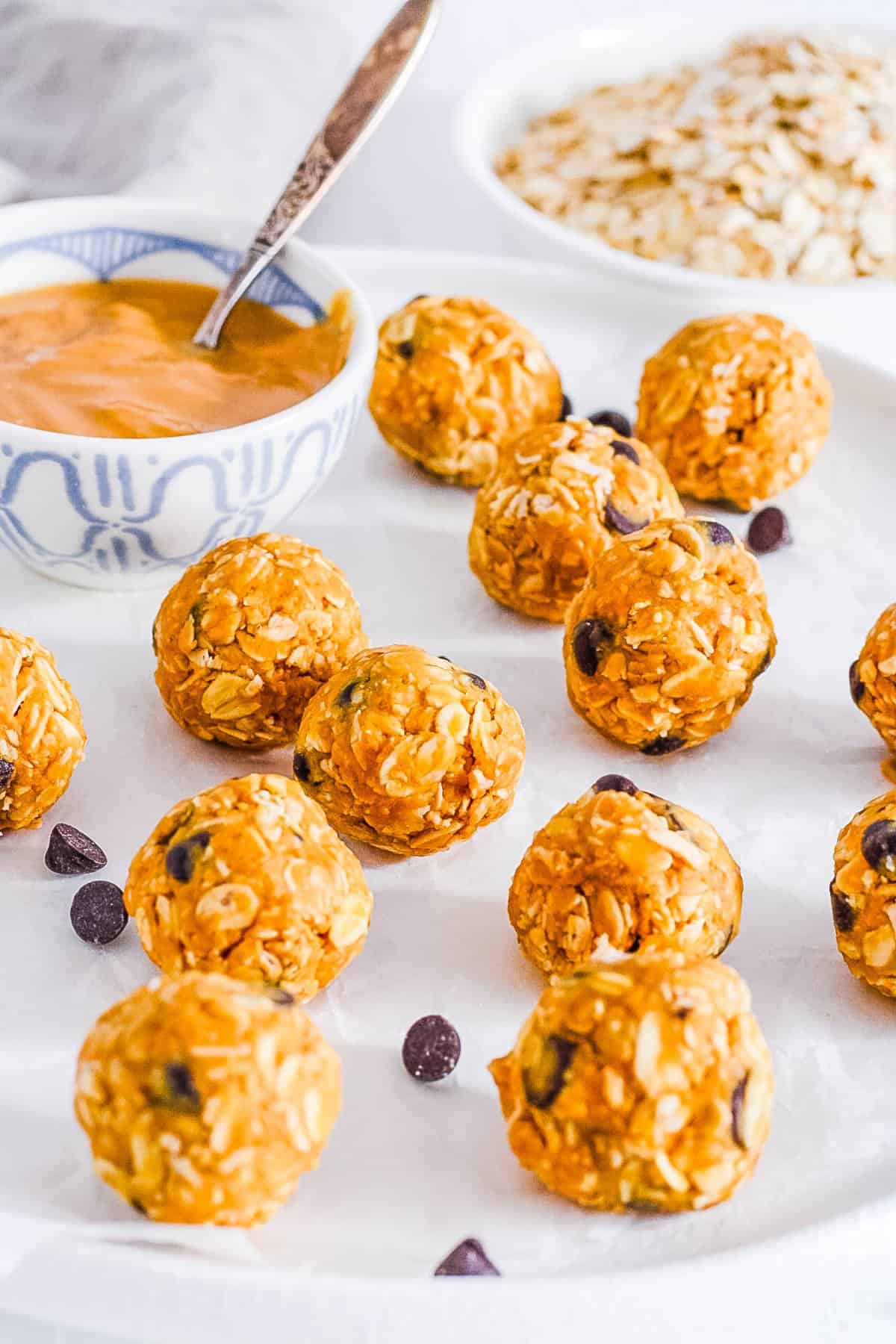
Indulge in my delicious no-bake peanut butter bliss balls, affectionately called “cookie dough bites” by my daughter. They taste like dessert, but are totally guilt-free and nutrient-rich! I love bliss ball recipes like this one because they come together quickly, and always satisfy my sweet tooth!
With only five simple ingredients and just ten minutes of prep time, bliss balls are a perfect option for busy days. I especially love making a huge batch at the beginning of the week, and enjoying them all week long for ultimate convenience. I find that they taste even better the next day, once they’ve had time to chill in the fridge for a while longer!
These protein balls with peanut butter are such a fun treat for any time of day! I really love how versatile they are – I’ll often use them as part of a quick breakfast, for packing in my kids’ lunches, or as a mid-afternoon snack.
Made with natural peanut butter, hearty oats, and a touch of pure maple syrup, I’ve crafted these bliss balls to be as healthy as possible. You won’t find any refined sugar here, even with these healthy swaps they still taste just like cookie dough. And each ball has only 90 calories and 3 grams of sugar!
I’ve also made sure that these wholesome ingredients can come together with minimal equipment required. No need to deal with your bulky food processor and spend all that extra time cleaning!
And my all time favorite thing about this recipe is that it’s a great way to involve kids in the kitchen. My kids have so much fun helping me out and adding in their own special twists.
Your family can also customize them in so many different ways, changing things up based on your preferences! I’ll share my favorite variations later in this post (like my peanut butter bliss balls with protein powder)!
Latest Recipe Video!
🥘 Ingredients
My easy peanut butter bliss balls recipe calls for just 5 nutritious ingredients, all easily found in your pantry or local grocery store. Here’s what you need:
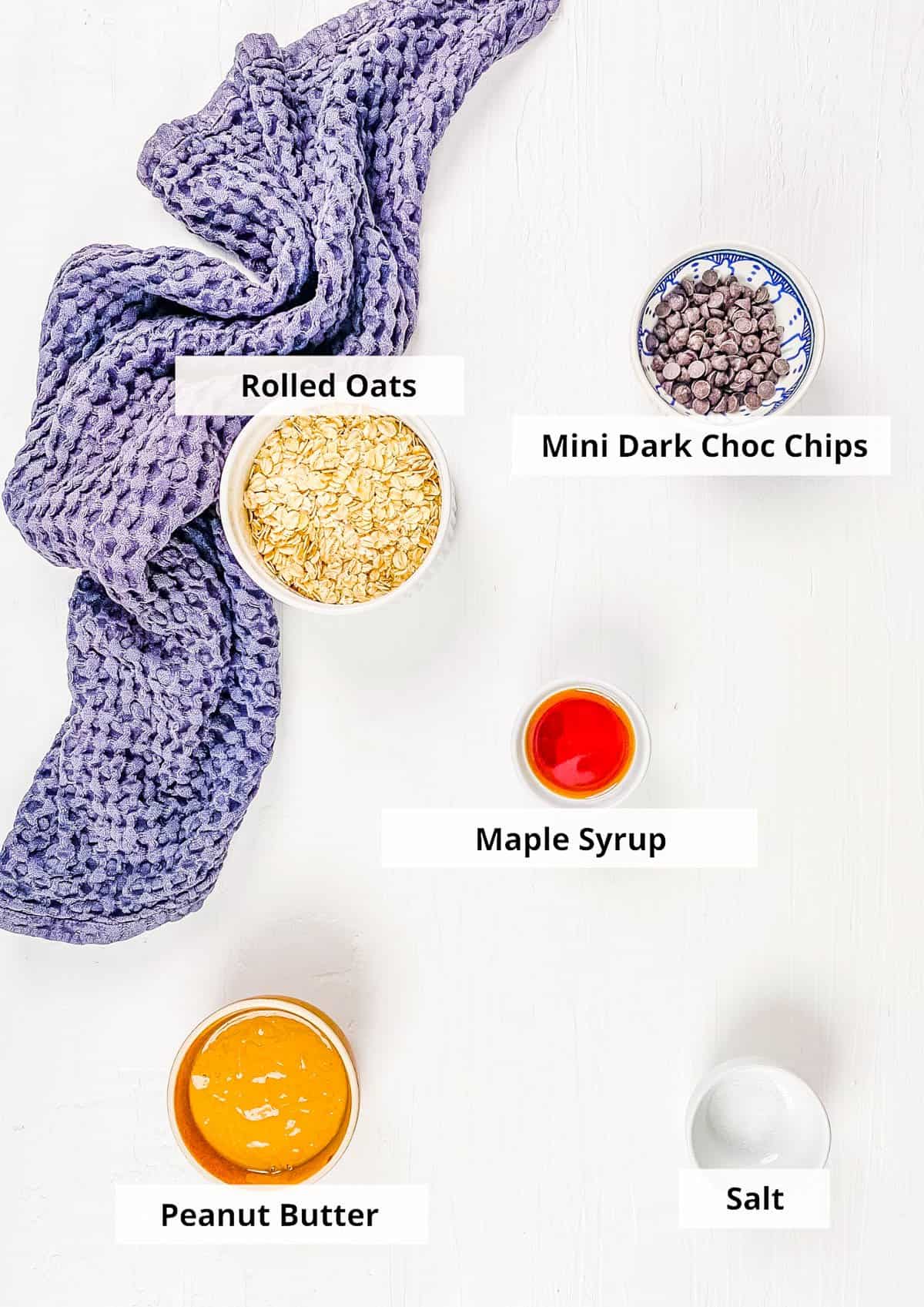
Oats: I’ve found that rolled oats work best for these kid-friendly bliss balls. I don’t recommend using oat flour or quick oats as it won’t have the same texture as whole oats, and won’t hold up as well.
Natural Peanut Butter: I use creamy peanut butter to bind all the ingredients together and add a boost of protein to these energy bites. If you don’t have peanut butter, try almond butter as a 1:1 substitute. Other nut butters (like cashew butter or a mixed nut butter) should also work in place of peanut butter, but the bites might have a slightly different consistency since some nuts create a thinner or runnier butter than others!
Dark Chocolate Chips: I prefer using dark chocolate chips for a healthier choice. These can be regular or mini chocolate chips. To keep this recipe vegan-friendly, I’ll use dairy-free chocolate chips. If you don’t need these to be vegan, then semisweet, white chocolate, or milk chocolate chips are all yummy options.
Maple Syrup: The only added sugar is natural maple syrup which gives the bliss balls a slightly sweet taste. If you don’t have maple syrup on hand, agave, raw honey, or vegan honey work.
Vanilla Extract: Pure vanilla extract brings out the richness of the chocolate. Sometimes I also add a pinch of salt to really enhance the sweetness. For a nutty flavor, try using almond extract.
🔪 How To Make Peanut Butter Bliss Balls
My vegan no bake peanut butter balls are so easy to make – they’re ready in just 3 simple steps. Let me show you how to make these healthy dessert balls:
Combine Ingredients: In a large bowl, using a wooden spoon, I start by stirring together the oats, peanut butter, chocolate chips, maple syrup, vanilla, and salt until combined.
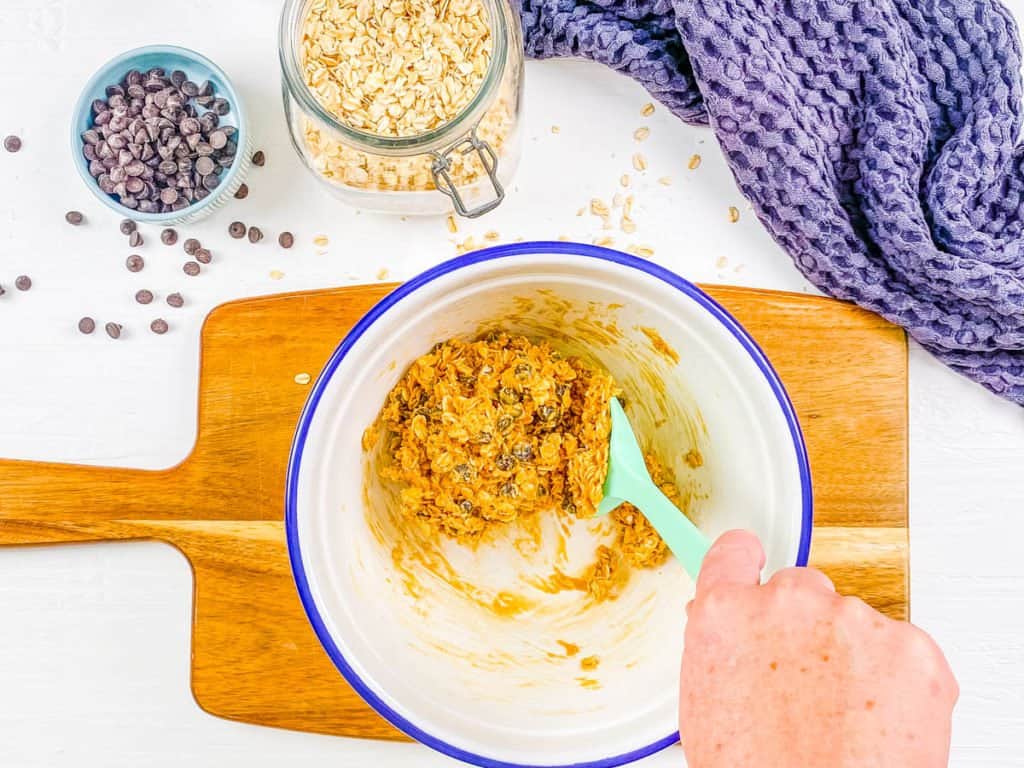
Form The Bliss Balls: Next, I line a baking sheet with parchment paper. Taking small handfuls of the mixture, I roll them into small balls 1-2 inches in size – about the size of a golf ball or ping pong ball. I prefer to use a cookie scoop to make this step extra easy. Place each ball onto the baking sheet.
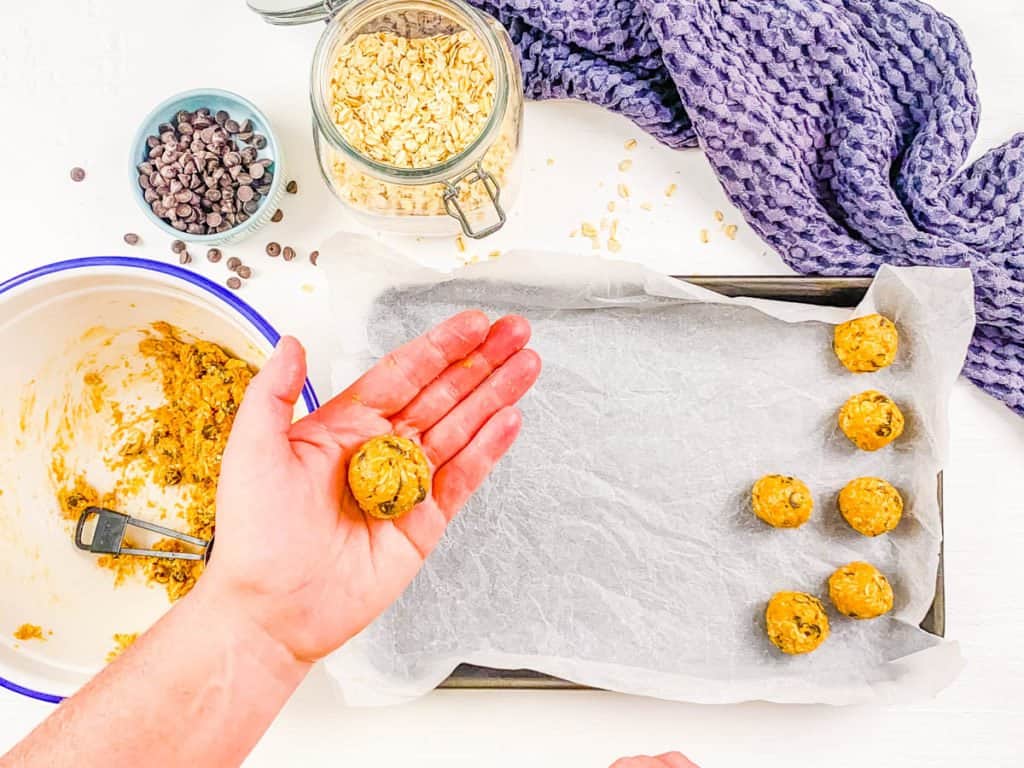
Let The Balls Set: Once rolled, I refrigerate these peanut butter snack balls for 30 minutes or until solid.
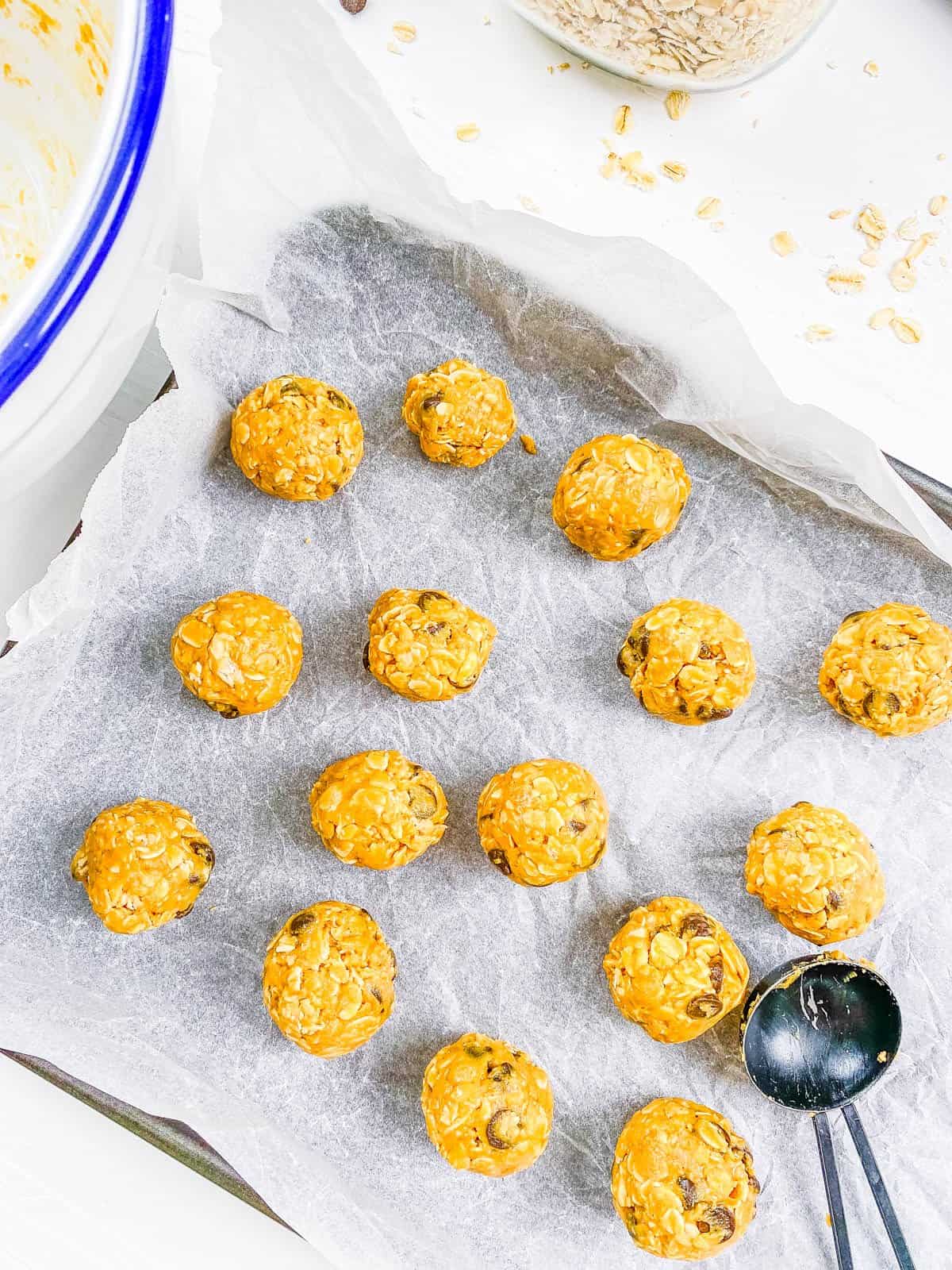
My #1 Secret Tip for this recipe is to make sure you measure ingredients precisely, with the right ratio of wet to dry ingredients.
While there is a little wiggle room with these bliss balls due to them being a no-bake recipe, I recommend being precise with all measurements to ensure ensures that the mixture has the right consistency to hold together without being too sticky or crumbly.
The creamy peanut butter is critical as the binding ingredient for these bliss balls, and I find it to be especially important to measure correctly. Too much or too little will throw the whole recipe off, leading to a mixture that is either too wet and sticky or too dry and crumbly.
After trial and error, I have found that achieving this balance is important for forming perfect bliss balls that stay intact and have a great texture.
Other Tips To Keep In Mind:
- Use The Right Tools: I like to use a cookie scoop to get all of these no-bake bliss balls the same size and to help my hands stay mess free!
- Check The Oats: If you or someone in your family is gluten intolerant, be sure to check the packaging on your oats for gluten-free certification. Some oats can be at risk for contamination with gluten substances.
- Involve The Kiddos: My kids love to help out in the kitchen, and this no-bake recipe is perfect for kids of all ages! They can learn how to measure out ingredients, combine ingredients, and roll the mixture into perfect ball shapes!
- Adjust For Moisture: If the dough seems too wet to mold into balls, consider adding a tablespoon or two of oat flour or almond flour. This will help to firm the mixture up so that it holds its shape and doesn’t stick to your hands.
- Bliss Balls For Kids: If you want to make these as toddler peanut butter balls I recommend reducing or omitting the sugar! You might also want to cut them into smaller bites when serving.
📖 Variations
I’ve perfected a few easy swaps and add-ins for when I’m looking to switch up the taste or texture a bit with these healthy kid-friendly bliss balls. There is something for any occasion! Here are my favorite variations:
Peanut Butter Protein Balls: If you want to turn these peanut butter protein bliss balls, consider adding a scoop of vegan vanilla protein powder to the batter before mixing it. You can use up to 2 scoops of protein powder, depending on the flavor of the protein powder you use. Sometimes I also add 1 tablespoon of ground chia seeds, flax seed, or hemp seeds for an extra boost of protein and healthy fats.
Chocolate Bliss Balls With Peanut Butter: For a double serving of chocolate, add a tablespoon of cacao or cocoa powder to the batter before mixing. I love the rich and indulgent flavor that this gives this recipe! I serve this as a healthy kids dessert often!
Peanut Butter Date Bliss Balls: For a sweeter flavor, I like to add a ¼ cup of Medjool dates, soaked and drained. I use a food processor when adding dates so that they are completely incorporated with the peanut butter and oats.
Sugar-Free Bliss Balls: If you want to make these no-bake peanut butter balls truly sugar-free, you can omit the maple syrup and use sugar-free chocolate. I think they still taste pretty good thanks to the natural sweetness from the vanilla and chocolate chips! If you are making these peanut butter balls for toddlers, this is a good option.
Mix-Ins: Add your favorite mix-ins to give these peanut butter energy balls some texture. I find that crushed walnuts, pecans, peanuts, sunflower seeds, and cacao nibs work really well in this recipe. My other favorites are dried fruit like cranberries, raisins, dried apricots, and shredded coconut. I also love adding spices like a pinch of sea salt, cinnamon powder, nutmeg, or pumpkin pie spice into the mixture. When making these as toddler protein balls, be mindful of the size of the nuts and dried fruit.
🍽 Serving Suggestions
While I love these healthy bliss balls with peanut butter on their own for an easy grab-and-go snack or healthy dessert, it can be so fun to get creative with other ways to serve these! Try some of these ideas:
Toppings: For a decadent dessert I love to drizzle chocolate sauce or caramel sauce (like the one on this no-bake salted caramel cheesecake) over these no bake snacks!
Ice Cream: My kids love to mix these no bake peanut butter dessert balls into tofu ice cream for a delicious treat.
Drinks: Energy balls can be found at a lot of coffee shops nowadays, so it only feels right to create those coffee shop vibes at home! I have been loving these balls with my oatmilk honey latte or iced ube latte! You can also do a creamy mixed berry smoothie alongside these protein balls for kids as an afternoon snack.
With Other Energy Bites: Make a spread of energy bites and serve these alongside my vegan protein balls, peanut butter date balls, and these homemade lara bars! I love this idea for parties and special occasions!
🫙 Storage Instructions
Room Temperature: I store these dairy free peanut butter balls in an airtight container at room temperature for up to 3 days.
To Refrigerate: After placing in an airtight container or resealable plastic bag, I’ll store these in the fridge for maximum freshness. They’ll be good for about one week!
Freezer: I don’t recommend storing these vegan energy balls in the freezer as they won’t taste as good when defrosted.
❓Recipe FAQs
The best type of peanut butter to use is natural peanut butter with no added sugars, oils, or preservatives. I recommend looking for a brand that has just one ingredient listed: peanuts. You can also use a brand that has peanuts and salt listed as the only two ingredients.
There are two ways I’d recommend adjusting this recipe if your mixture is too dry: 1) Add more peanut butter – it’ll help bind the ingredients and add moisture. 2) Add a little bit of coconut oil, maple syrup, or even a touch of applesauce – these ingredients will add moisture and flavor to your peanut butter oat balls!
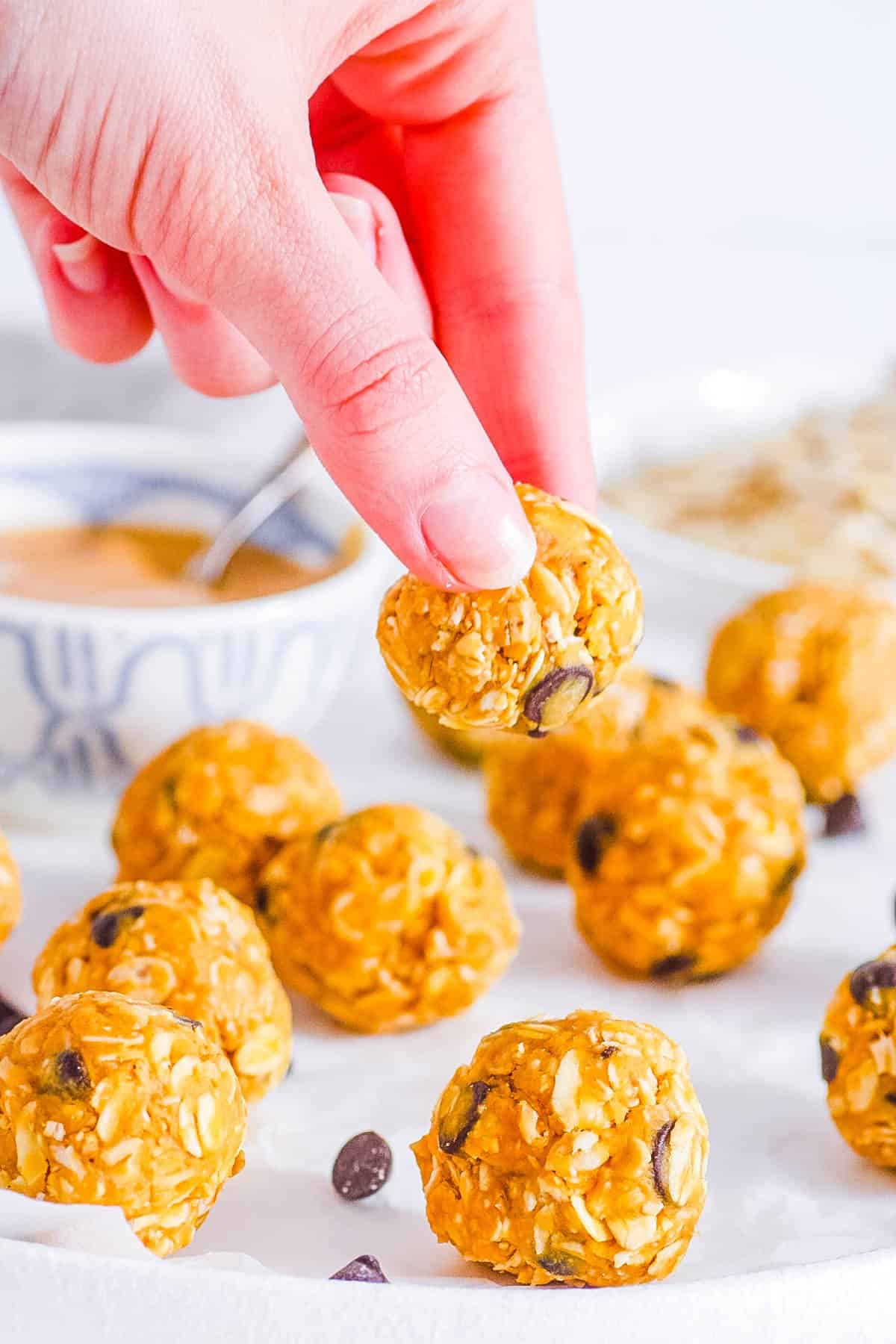
Want to Save This Recipe?
Enter your email & I’ll send it to your inbox. Plus, get great new recipes from me every week!
By submitting this form, you consent to receive emails from The Picky Eater.
Love this plant based dessert recipe? Please leave a 5-star rating 🌟 in the recipe below and/or a review in the comments section further down the page!
You can also FOLLOW ME on FACEBOOK, INSTAGRAM, and PINTEREST to see more delicious, healthy, family-friendly food, and if you have any questions, I’m here to help!
📋 Recipe Card
Healthy No-Bake Peanut Butter Bliss Balls
My healthy, easy no bake peanut butter bliss balls are loaded with creamy peanut butter and chocolate flavor, making them a hit with both kids and adults alike. Enjoy these as an on-the-go breakfast, wholesome snack, or healthy dessert alternative! They’re also dairy-free, vegan, gluten-free, and low in sugar, making them ideal for a variety of dietary preferences.
Servings: 16 balls
Calories: 93kcal
-
In a large bowl, using a wooden spoon, stir together the oats, peanut butter, chocolate chips, maple syrup, vanilla, salt (and protein powder, if using) until combined.
-
Line a baking sheet with parchment paper.
-
Taking small handfuls of the mixture, roll them into small balls 1-2 inches in size. Or you can use a cookie scoop. Place them onto the baking sheet.
-
Refrigerate the bites for 30 minutes or until solid. Store in an air-tight container in the fridge (they will last at least 1 week, and likely 2!)
- Use The Right Tools: Use a cookie scoop to get all of the balls the same size.
- Check The Oats: If you or someone in your family is gluten intolerant, be sure to use gluten-free oats.
- Involve The Kiddos: This is such a great no bake recipe for kids to make – get them in the kitchen!
- Adjust For Moisture: If the dough seems too wet to mold into balls, consider adding a tablespoon or two of almond flour.
- Sugar Free: If you want to make these truly sugar-free, you can omit the maple syrup, and they will still taste pretty good.
- Peanut-Free: Use your favorite alternative nut butter or seed-based butter.
- Nutritional information includes protein powder. Note: for even more protein, use 1 scoop of vegan vanilla protein powder and 1 scoop of peanut butter protein powder.
Serving: 1ball | Calories: 93kcal | Carbohydrates: 8g | Protein: 4g | Fat: 5g | Saturated Fat: 2g | Polyunsaturated Fat: 1g | Monounsaturated Fat: 2g | Cholesterol: 4mg | Sodium: 43mg | Potassium: 92mg | Fiber: 1g | Sugar: 3g
Health
Federal Experts Talk Bird Flu ‘What Ifs’ in WebMD Live Event

May 16, 2024 – Multiple U.S. agencies are working to contain the recent bird flu outbreak among cattle to prevent further spread to humans (beyond one case reported in early April) and use what we learned before, during, and after the COVID-19 pandemic to keep farm workers and the general public safe.
Fingers crossed, the bird flu will be contained and peter out. Or the outbreak could continue to spread among dairy cattle and other animals, threatening the health and livelihoods of farmers and others who work with livestock.
Or the virus could change in a way that makes it easier to infect and spread among people. If this happens, the worst-case scenario could be a new influenza pandemic.
With so many unknowns, WebMD brought together experts from four federal agencies to talk prevention, monitoring, and what the “what ifs” of bird flu might look like.
Communication with the public “about what we know, what we don’t know, and ways you and your family can stay safe is a priority for us at CDC,” said Nirav D. Shah, MD, JD, the CDC’s principal deputy director. “We at the federal level are responding, and we want the public to be following along.”
People should consult the websites for the CDC, FDA, U.S. Department of Agriculture (USDA), and the Administration for Strategic Preparedness and Response (ASPR) for updates.
It is essential to not only stay informed, but to seek trusted sources of information, Shah said during “Bird Flu 2024 – What You Need to Know,” an online briefing jointly sponsored by the CDC and WebMD.
An ‘Experimental Hamburger’
If one take-home message emerged from the event, it was that the threat to the general public remains low.
The retail milk supply is safe, although consuming raw or unpasteurized milk is not recommended. “While commercial milk supply is safe, we strongly advise against drinking raw milk,” said Donald A. Prater, DVM, acting director for the FDA’s Center for Food Safety and Applied Nutrition.
As for other foods, thoroughly cooked eggs are less risky than raw eggs, and the nation’s beef supply remains free of the virus as well.
For years, federal inspectors have purchased and tested meat at retail stores, said Eric Deeble, DVM, USDA deputy assistant secretary for the Office of Congressional Relations. So far, H5N1, the virus behind bird flu, has not been detected in beef.
The USDA took testing a step further and recently cooked ground beef from dairy cows in their lab. Using what Deeble described as an “experimental hamburger,” the agency showed cooking beef to 165 F or higher kills the virus if it ever becomes necessary.
The federal government now requires all cattle be tested and be free of bird flu virus before crossing any state lines. The government is also reimbursing farmers for veterinary care and loss of business related to the outbreak, and supply personal protective equipment (PPE) like gloves, masks, and face shields to workers.
Vaccination Not Recommended Now
Federal scientists know enough about H5N1 virus to create vaccines against it quickly if the need arises. It’s more about planning ahead at this point. “Vaccines are not part of our response right now,” said David Boucher, PhD, director of infectious diseases preparedness and response at the Administration for Strategic Preparedness and Response.
If the virus changes and becomes a bigger threat to people, “we have the building blocks to produce a vaccine,” Boucher added.
An event attendee asked if the seasonal flu shot offers any protection. “Unfortunately, the flu shot you got last year does not provide great protection from the avian flu,” Shah responded. “It might do a little bit … but that is the vaccine for seasonal flu. This is something more novel.”
Treatments Stockpiled and Ready
Antiviral medications, which if given early in the course of bird flu infection could shorten the severity or duration of illness, are available now, Shah said. The dairy farmer who was infected with bird flu earlier this year responded to oseltamivir (Tamiflu) treatment, for example.
When it comes to bird flu symptoms, the fact that the only infected person reported so far this year developed pink eye, also known as conjunctivitis, is interesting, Shah said. Officials would have expected to see more typical seasonal flu symptoms, he added.
“Influenza is not a new virus,” Boucher said. “With this strain of influenza, we are not seeing any genetic markers associated with resistance to antivirals. That means the antivirals we take for seasonal influenza would also be available if needed to treat H5N1.”
ASPR has stockpiled Tamiflu and three other antivirals. “We do have tens of millions of courses that can be distributed around the country if we need them,” he added.
“Influenza is an enemy we know well,” Boucher said. That is why “we have antivirals ready to go now and many types of PPE.”
Science in Action
The feds intend to stay on the case. They will continue to monitor emergency department visits, lab test orders, and wastewater samples for any changes suggesting a human pandemic risk is growing.
“While we’ve learned a great deal, there are still many things we do not know,” Deeble said.
Shah added, “As in any outbreak, this is an evolving situation and things can change. What you are seeing now is science in action.”
For the latest updates on bird flu in the United States, visit the CDC’s H5N1 Bird Flu: Current Situation Summary website.
-

 African History4 months ago
African History4 months agoBlack History Facts I had to Learn on My Own pt.6 📜
-

 African History4 years ago
African History4 years agoA Closer Look: Afro-Mexicans 🇲🇽
-

 African History1 year ago
African History1 year agoPROOF AFRICAN AMERICANS AIN'T FROM AFRICA DOCUMENTED EVIDENCE
-

 African History2 years ago
African History2 years agoHow Did Normal Medieval People Survive Winter? | Tudor Monastery Farm | Chronicle
-

 African History4 years ago
African History4 years agoA Closer Look: Afro-Mexicans 🇲🇽
-

 African History3 years ago
African History3 years agoThe Entire History of Africa in Under 10 Minutes – Documentary
-

 African History3 years ago
African History3 years agoWhat happened to the many African Kingdoms? History of Africa 1500-1800 Documentary 1/6
-

 African History2 years ago
African History2 years agoAFRO MEXICO: Black History In Mexico!

